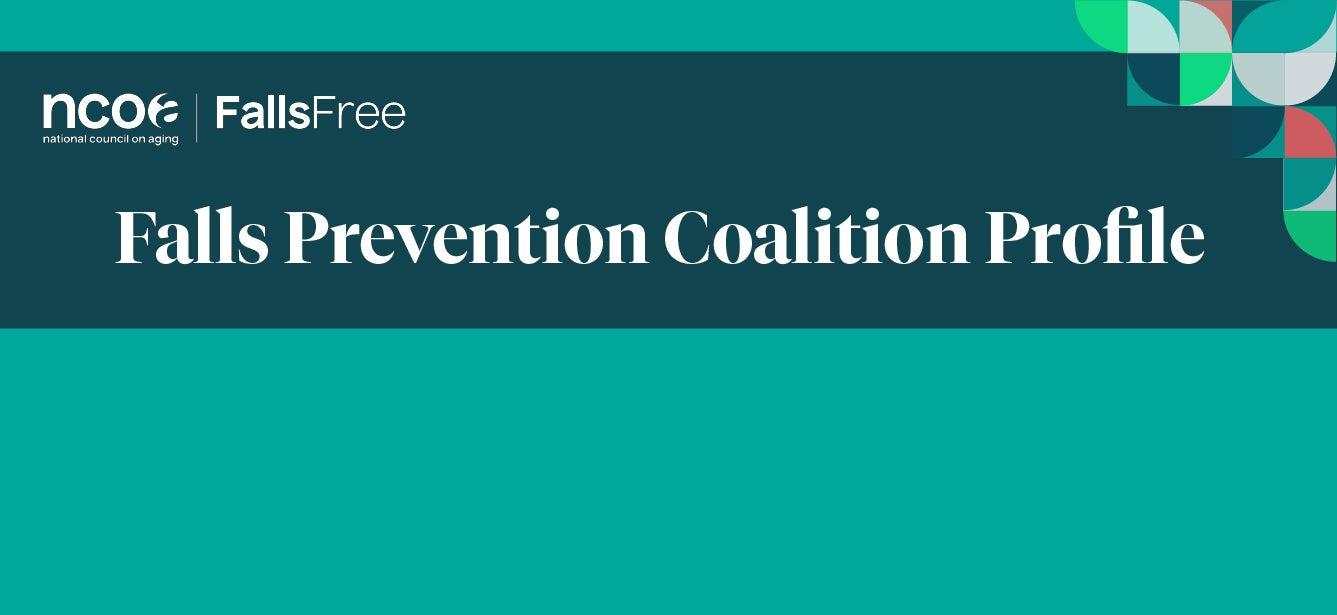
While establishing a Falls Prevention Coalition by any one of these North Carolina organizations might have proven to be a daunting task, this group—enhanced by the addition of the UNC Center for Aging and Health—provided a strong core of agencies with diverse strengths, funding sources, and networks that combined into a successful partnership.
The history of the North Carolina State Falls Prevention Coalition
In February 2007, in conjunction with several aging and chronic disease related grants on which the North Carolina (NC) Division of Aging and Adult Services (DAAS) and the NC Division of Public Health (DPH) were partnering, the two divisions entered into a written memorandum of agreement, formalizing their respective commitments to each other and the intent to partner on future projects. Both Divisions were also working on a grant with the Institute on Aging (now defunct) at the University of North Carolina (UNC) at Chapel Hill. As a result of ensuing dialogue between all three agencies, they quickly recognized shared concerns over the high morbidity and mortality associated with falls in the older adult population that would, without significant intervention, increase substantially as baby boomers aged. All three agencies were also aware of interest being generated on the national level around falls prevention.
The first North Carolina Falls Prevention Coalition (NCFPC) meeting was held April 30, 2008. Interest was very high, with numerous key leaders and stakeholders present from a multitude of organizations. The need was agreed upon and the Coalition mission and goals were identified. At the second coalition meeting in July 2008, Coalition members began to address strategies to meet the goals and objectives.
The Coalition’s mission is to reduce the number of injuries and deaths from falls among adults in NC.
North Carolina State Falls Prevention Coalition strategies:
- Maintain a statewide structure to coordinate falls reduction efforts through supporting and strengthening regional falls prevention coalitions and statewide partnerships.
- Share and promote evidence-based falls prevention programs and resources, and current activities, research, and projects happening across the state.
- Raise awareness of the burden of falls and of the strategies to reduce falls, such as routine screening for falls.
- Cultivate relationships with new partners and promote falls prevention education and training to all partners in NC.
- Advocate for policy changes and resources to reduce falls as a prevention tool.
- Increase visibility and understanding of falls prevention data through strategies to improve data collection and analysis.
Current goals and objectives for the North Carolina Falls Prevention Coalition
In its 2021-25 action plan, the North Carolina Falls Prevention Coalition has stated it will pursue the following strategic goals:
- Enhance opportunities for collaboration & networking among falls prevention partners
- Prevent falls through comprehensive and coordinated clinical and community integration
- Increase public awareness efforts and statewide advocacy for policies and systems.
Leadership for the North Carolina State Falls Prevention Coalition
- North Carolina Center for Health and Wellness at the University of North Carolina Asheville
- North Carolina Division of Public Health, Injury and Violence Prevention Branch
- Thurston Arthritis Research Center/Osteoarthritis Action Alliance at the University of North Carolina Chapel Hill
- North Carolina Division of Aging and Adult Services
- Coastal Carolina Active Living at Shallotte
- North Carolina Alliance of YMCAs
- APTA Geriatrics
- AARP-NC
- Current Steering Committee members
Leadership Contact Information
- Chair:
- Ellen Bailey, MA, MPH, Falls Prevention Grant Manager, Healthy Aging NC Initiative at the North Carolina Center for Health Wellness (NCCHW) at UNC Asheville; 828-255-7072 (office); ebailey@unca.edu (email)
- Co-Chair:
- Ingrid Bou-Saada, MA, MPH, Injury Prevention Consultant, Division of Public Health, Injury and Violence Prevention Branch at the NC Department of Health and Human Services; 919-707-5435 (office); Ingrid.Bou-Saada@dhhs.nc.gov (email)
- Action Plan Implementation Lead:
- Divya Venkataganesan, MPH, Falls Prevention Project Specialist, North Carolina Center for Health Wellness (NCCHW) at UNC Asheville; Human Services Planner/Evaluator, Division of Aging and Adult Services at the NC Department of Health and Human Service; dvenkata@unca.edu (email)
Key Partners for the North Carolina State Falls Prevention Coalition
- Regional Coalitions
- Cape Fear Falls Prevention Coalition
- Eastern North Carolina Falls Prevention Coalition
- High Country Regional Coalition
- Metrolina Falls Prevention Coalition
- Piedmont Area Falls Prevention Coalition
- Triangle Falls Prevention Coalition
- Western North Carolina Falls Prevention Coalition
- Community: Clinical/Healthcare & Bridge/Transitional
- University of North Carolina (UNC) Trauma
- Duke Trauma
- East Carolina University (ECU) Health Medical Center
- Moses Cone Hospital
- Mission Health Trauma
- Murdoch Developmental Center
- Brain Injury Association of North Carolina
- Association for Home and Hospice Care of NC
- American Podiatric Medical Association (APMA)
- North Carolina Physical Therapy Association
- Liberty Healthcare
- Alzheimer's Association
- The Audiology Project
- Alignment Healthcare
- Area Health Education Centers (AHECs)
- North Carolina Center for Health and Wellness at UNC Asheville
- East Carolina University – Geriatrics Workforce Enhancement Program
- UNC Geriatrics Workforce Enhancement Program
- UNC Eshelman School of Pharmacy
- UNC Physical Therapy Department
- UNCW Gerontology Program
- Durham Tech Community College
- Winston-Salem State University: Physical Therapy Department and Occupational Therapy Program
- Atrium Wake Forest Baptist Medical Center
- Campbell University DPT Program
- Community Health Center Association
- North Carolina Alliance of YMCAs
- Universal Design Institute
- ElderFit
- Aging Networks and Other Community Based Services and Philanthropy
- Adult Life Programs, Inc.
- Area Agencies on Aging
- Resources for Seniors
- North Carolina PACE (Program for All-Inclusive Care for the Elderly) Association
- North Carolina Assisted Living Association
- North Carolina Baptist Aging Ministry
- Community Foundation of Greater Greensboro
- Government/State Agencies
- North Carolina DHHS Division of Aging and Adult Services (DAAS)
- North Carolina DHHS Division of Public Health (DPH)
- North Carolina DHHS Division of Mental Health, Developmental Disabilities and Substance Abuse Services (DMH)
- North Carolina DHHS Division of Services for the Deaf and Hard of Hearing (DSDHH)
- North Carolina Division of Insurance (DOI)
- North Carolina Office of Rural Health
- North Carolina General Assembly
- Wilmington Fire and Rescue Department
- Advocacy
- North Carolina Senior Tar Heel Legislature (STHL)
- Governor's Advisory Council (GAC)
- American Association of Retired Persons North Carolina (AARP NC)
- Community advocates
Key partners who participated in the strategic planning retreat in 2019.
What has the North Carolina State Falls Prevention Coalition achieved?
- Led a strategic planning process in 2019, which resulted in a 5-year NC Falls Prevention Coalition Action Plan;
- Leveraged coalition partnerships to advocate for and fund the NCIOM Healthy Aging Task Force, and secured NC DPH IVPB CDC Core Injury funding to partially support the work of the coalition; and
- Secured Governor's Proclamation for Falls Prevention since 2009.
What are the current challenges for the North Carolina State Falls Prevention Coalition?
- Maintaining momentum and participation in Action Plan work groups and implementing full action plan with a primarily volunteer group;
- Attracting community-dwelling older adults and all 100 counties to participate in coalition activities; and
- Securing consistent funding to support falls prevention efforts.
What evidence-based falls prevention programs are currently offered by the North Carolina State Falls Prevention Coalition?
- A Matter of Balance
- Enhance Fitness (YMCA)
- Tai Chi for Arthritis and Fall Prevention
- The Otago Exercise Program
- Moving For Better Balance (YMCA)
- Bingocize
What outcomes are monitored by the North Carolina State Falls Prevention Coalition?
- Coalition membership
- Number of counties connected to regional coalitions
- Achievements of Action Plan through action steps
- Tracking participation in FPAW
- Number of participation in evidence-based falls prevention programs through statewide partners
- Data metrics associated with falls (Falls deaths, hospitalizations, ED visits, associated TBI)

